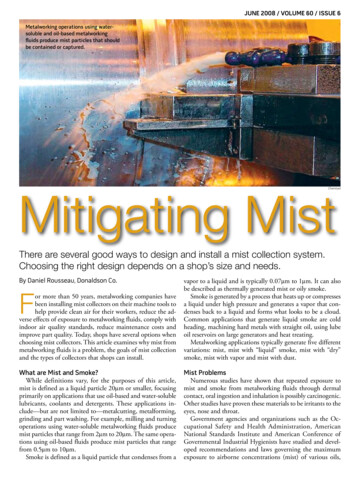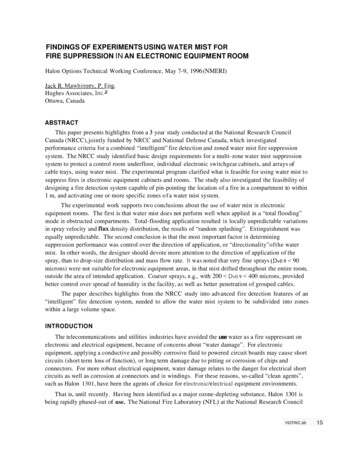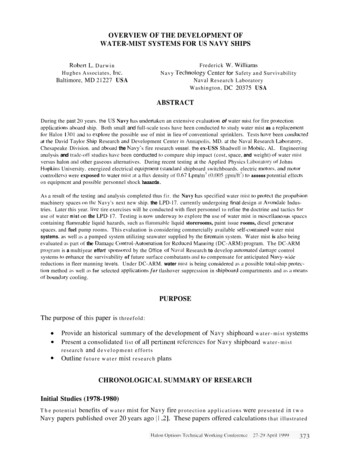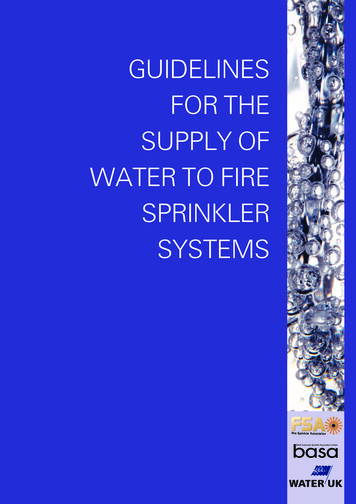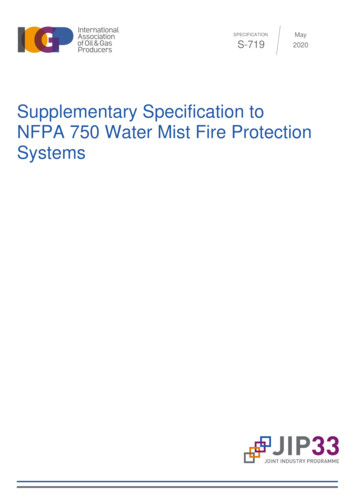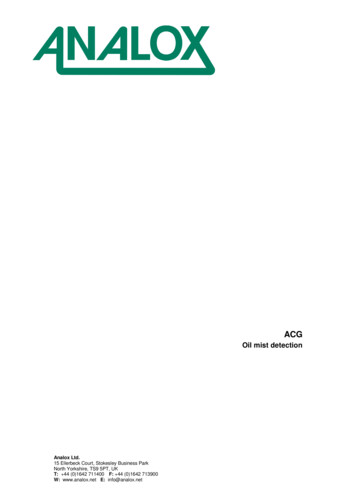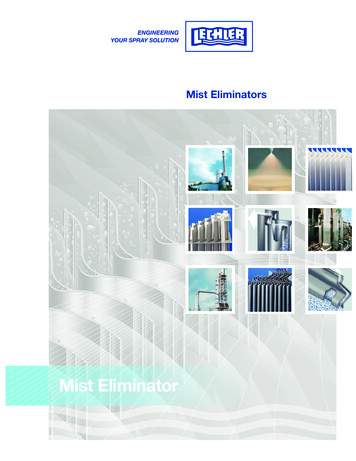
Transcription
Water MistFire SuppressionHow less water has a big impact.
HELPING PROTECT YOUR BUSINESS AND VALUED ASSETS WITH WATER MIST FIRE PROTECTION SYSTEMINTRODUCTIONMany buildings have specific areas that could benefit from using a water mist system. These systems use lesswater than traditional sprinkler systems, causing less damage to high-value assets. This white paper provides ageneral overview of water mist technology, the types of water mist systems currently on the market and what tolook for when specifying a water mist system.HOW FIRE OCCURSIn order to understand how water mist systems work, we need to understand how fires occur. Four things mustbe present at the same time in order to produce fire: fuel, heat, oxygen and a chemical reaction. The first threeelements are frequently referred to as the “Fire Triangle.” Adding the fourth element (chemical reaction) will resultin the “Fire Tetrahedron.” Removal of any one of these elements will result in fire extinguishment and the disruptionor weakening of one of these elements will result in fire control or suppression. Essentially, water mist takes awayone or more elements of the Fire Triangle or Tetrahedron.HOW DOES WATER MIST WORK?Water mist systems can control fire by reducing heat, displacing oxygen and controlling the fuel source by wettingand cooling the surrounding fuel surfaces. The key to water mist technology lies in the design of the nozzle alongwith established pressure criteria to create a mist of small water droplets. Water mist systems will have dropletsizes where 99% of the volumetric diameter is less than 1mm. Smaller droplets absorb heat at a faster rate thanlarger droplets due to the higher surface area-to-mass ratio. A volume of water that consists of smaller dropletshas a comparatively larger cumulative surface area than the same volume of water made up of larger droplets –such as those from a standard spray sprinkler. As a result, a rapid absorption of heat and evaporation of thesmallest droplets will occur, causing temperatures to decrease while oxygen is displaced.When the water droplets absorb enough heat,they evaporate, rapidly creating steam.Due to this vaporization, oxygen will be displaced in the area of the fire, disrupting the Fire Tetrahedron. Smallwater droplets tend to remain suspended in the air and fill the entire space. The result being that any air the firedraws in becomes saturated with these droplets and vaporization occurs. Water mist also helps to pre-wet andblock the transfer of radiant heat to the adjacent combustibles, reducing the risk of fire to spread and grow.TYPES OF WATER MIST SYSTEMSThere are three main categories of water mist systems: low pressure (175 psi or less), intermediate pressure (175psi-500 psi) and high pressure (500 psi or greater). Within these categories you may have single-fluid systems(water only) or twin-fluid systems (water and an atomizing medium like nitrogen). All these system types aretested and approved for a variety of fire hazards and should be handled as an engineered water mist system, eachrequiring specific design and calculation criteria. An example of a low to intermediate pressure water mist systemis the AquaMist Ultra Low Flow (ULF) which operates at working pressures up to 250 psi (17.2 bar). The AquaMist FOG, which is a high-pressure system, operates at working pressures of 1015 psi to 2900 psi (70 to 200 bar). Thehigh-pressure system typically produces very fine droplets (less than 50 um) and uses even smaller pipe sizes thanthat of low to intermediate pressure systems.2White Paper - AquaMist Fire Protection System
A twin-fluid system is a hybrid water mist system like theAquaMist SONIC System. This system requires water andnitrogen gas to extinguish the fire. Both the water and thenitrogen gas require separate sources towards the nozzle andthen the gas is used to “shear” the water stream into fine waterdroplets. AquaMist SONIC uses operating pressures of 58.02psi to 101.52 psi for nitrogen and 29.00 psi to 58.02 psi (4 to 7bar for nitrogen and 2 to 4 bar for water) at the nozzles beforeentering the protected area to extinguish the fire.The hybrid water mist system works as described previously;by cooling the surroundings and displacing oxygen, but now theinert nitrogen gas helps to further reduce the overall oxygenlevel in the space for faster extinguishment of fire. This systemuses less inert gas than what is required in a traditional cleanagent system because it utilizes the benefits of the local oxygendisplacement created by the conversion of water mist to steam.For each water mist system, different configurations can be found. There are automatic systems which utilizenozzles that have a thermal responsive element that hold back water until it operates. When exposed to a certainhigh temperature (from a fire) for a period of time, this thermal response element operates and allows water tocome out of the nozzle. These nozzles can be piped from a wet sprinkler valve or a pre-action valve. Regardless ofthe system type, wet or pre-action, water only enters the protected area from those nozzles of which the thermalresponse element has operated.Another type of system is the deluge system. This system utilizes open nozzles (no thermal element). With thissystem, an independent detection system (smoke or heat) is installed in the same area as the nozzles to controlthe deluge alarm valve. When smoke or heat is detected, an electronic signal is sent to a control panel which inturn sends a signal to the deluge valve and opens the valve. Water enters the system and provides water to allthe nozzles connected to the deluge valve. This provides protection for hazards within the space and is commonlyseen in machinery and turbine enclosures. The common name used for these types of water mist systems is a“total flooding” or “total compartment” system.When the compartment containing the machinery or turbine enclosure is of such a volume that a total compartmentsolution is not feasible, it will be decided to just protect the hazard locally with open nozzles and separate detection.This water mist system type is called a “local application.”BENEFITS OF WATER MISTThe main benefit of water mist is that it uses less water comparedto a traditional sprinkler system. This minimizes damage to theproperty and the critical assets. Also, due to the lower waterrequirements, the system can use smaller diameter piping. Thismay reduce the material cost as well as the installation cost ofthe system.A trade-off of using less water is that the water mist systemtypically needs higher pressure than what a municipal waterDigital integrity is a crucial aspect of commercialorganizational operations around the world.White Paper - AquaMist Fire Protection System3
HELPING PROTECT YOUR BUSINESS AND VALUED ASSETS WITH WATER MIST FIRE PROTECTION SYSTEMmain can provide. This can be accomplished by using positive displacement pump(s) which provide high-pressureoutput at lower water volumes, or by using stored nitrogen or air cylinders as a propellant for the water. Since thewater demand is lower, water mist systems are suitable for standalone applications where access to water maybe limited. In such situations, a water tank or cylinder(s) filled with water and pressurized by stored nitrogen or aircylinders can be used to supply the pump with water. With these standalone solutions, there is a finite dischargeduration due to limited amount of water stored.WHAT APPLICATIONS ARE BEST SUITED FOR WATER MIST TECHNOLOGY?Water mist systems can be used as a complete solution fornearly every class of fire. Examples of where water mist systemshave been used include, but are not limited to, archives, cabletunnels, data centers, heritage, hotels, industrial fryers, libraries,machinery spaces, offices and turbine enclosures.Machinery spaces that utilize hydrocarbon fuels and lubricants,as well as flammable and combustible liquids under pressure,can create fast-growing spray and pool fires. This type of firesuppresses quickly when using an applicable water mist solutiondue to its rapid heat absorption.Machinery spaces are facilities providingprocess critical services, such as water,electricity, heating and power.Large, industrial fryers can also benefit from water mist technology. Food manufacturers using large industrialfryers can suffer significant loss with fires that cause widespread damage and product loss (up to 1 million perday). Water mist nozzles can be installed directly within the hood system of the fryer to prevent fire from spreading.Heritage sites, such as museums, libraries and art galleries contain high-value, irreplaceable assets. While fireposes a tremendous risk to the preservation of these assets, saturation from fire suppression systems can alsocause significant damage. The lower water discharge of water mist systems helps reduce collateral damage tothese assets without sacrificing fire protection capabilities.SPECIFYING A WATER MIST SOLUTIONThe following considerations should be taken into account when specifying a water mist system. The first is theon-site water supply. The available water pressure often dictates the required water supply for the water mistsystem. If there is no adequate water supply, then a standalone system may be required as described previously.Secondly, water mist systems should conform to all local andstate codes, where applicable, as well as the requirements ofthe authority having jurisdiction (AHJ). For example, water mistsystems should meet the requirements outlined by NFPA 750,“Standard on Water Mist Fire Protection Systems.” Systems and/or components of water mist systems are tested and approvedby certifying bodies such as Factory Mutual (FM), UnderwritersLaboratory (UL) and VdS, and these listings and approvals areoften required by standards and AHJs.4Industrial fryersare cookerscommonly used inthe food industryto produceconsumables.White Paper - AquaMist Fire Protection System
MAKE THE RIGHT CHOICEAlthough water mist systems have been around for many years, they’ve only recently gained popularity in the U.S.These systems offer a powerful and economical solution that will help suppress or control the fire with minimalwater usage and collateral damage.The innovative, dependable and environmentally safe technology behind AquaMist systems is supported bycomprehensive industry approvals as well as independent, third-party testing and verification. The diversity of theAquaMist line, backed by the forward-thinking technology of Johnson Controls, assists in allowing companies toselect a water mist solution that fits the unique needs of their business. For more information on AquaMist WaterSuppression Systems, submit a contact form at http://tycoaquamist.comAquaMist ULF produces dropletsof water through a range ofnozzles, which are specificallyengineered and approved for avariety of fire hazards. Designedto function as one dedicatedfire protection system, it’s acomplete engineered solution thatincludes pumps, valves, dischargenozzles, pipes and fittings.Environmentally friendlyAquaMist SONIC uses readilyavailable water and nitrogenas extinguishing material. Twosupersonic atomizers create 1.5trillion superfine water dropletsper second and propel them athigh velocity to provide non-toxicfire suppression protection. Thissystem also provides automaticdetection and actuation and/or remote manual actuation.As a pre-engineered cylinderor engineered pumped system,AquaMist FOG provides fireprotection for class A and Bfires. Because these systemsreduce water consumption andpipe diameters, they are perfectfor machinery spaces, as wellas fragile infrastructures thatrequires specialist care, such asin heritage buildings, librariesand archives. This system is notyet available in North America.Contributions By: Ian Jutras, Project Engineer - Water Mist, Johnson Controls, Dennis Visser, Global ProductManager - Water Mist, Johnson Controls, Dennis M. Phillips, Business Development Manager - Johnson Controls,Seth Wood, Business Development Manager - Johnson ControlsWhite Paper - AquaMist Fire Protection System5
About Johnson ControlsJohnson Controls is a global diversified technology and multi-industrial leader serving a wide range of customers in morethan 150 countries. Our 120,000 employees create intelligent buildings, efficient energy solutions, integrated infrastructureand next generation transportation systems that work seamlessly together to deliver on the promise of smart cities andcommunities. Our commitment to sustainability dates back to our roots in 1885, with the invention of the first electric roomthermostat. We are committed to helping our customers win and to creating greater value for all of our stakeholders throughstrategic focus on our buildings and energy growth platforms.For more information, visit www.johnsoncontrols.com or follow @johnsoncontrols on Twitter.About Johnson Controls’ Building Technologies and SolutionsJohnson Controls’ Building Technologies & Solutions is making the world safer, smarter and more sustainable — one buildingat a time. Our technology portfolio integrates every aspect of a building — whether security systems, energy management, firesuppression or HVACR — to ensure that we exceed customer expectations at all times. We operate in more than 150 countriesthrough our unmatched network of branches and distribution channels, helping building owners, operators, engineers andcontractors enhance the full lifecycle of any facility. Our arsenal of brands includes some of the most trusted names in theindustry such as Tyco , YORK , Metasys , Ruskin , Titus , Frick , PENN , Sabroe , Simplex and Grinnell .For more information, visit www.johnsoncontrols.com or follow @JCI Buildings on Twitter.WORLDWIDE HEADQUARTERSEUROPEASIA PACIFICJohnson Controls,1400 Pennbrook ParkwayLansdale, PA 19446Tel: 1 215-362-0700 (Toll Free)Tel: 1 800-558-5236Fax: 1 800-877-1295www.tyco-fire.comJohnson ControlsKopersteden 1P.O. Box 1987500 AD EnschedeThe NetherlandsTel: 31 (0)53-428-4444www.tfppemea.comJohnson Controls,2 Serangoon North Avenue 5Tel: 65-6577-4360Fax: 65-6481-8791www.tyco-fire.com 2018 Johnson Controls. All rights reserved.
tested and approved for a variety of fire hazards and should be handled as an engineered water mist system, each requiring specific design and calculation criteria. An example of a low to intermediate pressure water mist system is the AquaMist Ultra Low Flow (ULF) which operates at working pressures up to 250 psi (17.2 bar). The AquaMist

